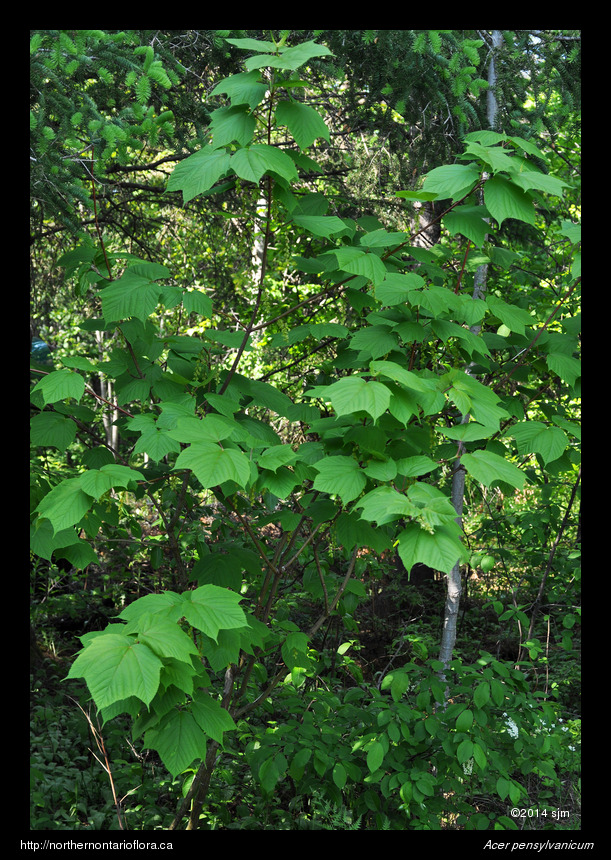
|
Northern Ontario Plant Database 
Plant DescriptionAcer pensylvanicum L.En: striped maple, moose maple, goosefoot maple
Sapindaceae (Soapberry Family) The Genus Acer: Maples are tall shrubs or trees with opposite, deciduous leaves. Most maples have simple, palmately-lobed leaves, with the exception of Acer negundo (Manitoba maple or box elder), which has pinnnately compound leaves. Most have buds with overlapping (imbricate) bud scales and narrow V- or U-shaped leaf scars with 3 bundle scars. The small bisexual or unisexual flowers have 5 sepals, 5 petals, 10 stamens and/or a 2-carpelled ovary surrounded at the base by a nectar-producing disk; the ovary develops into a pair of indehiscent, winged samaras, commonly called maple "keys", which are wind-dispersed. Some maple species are bisexual, others have both male and female parts in the same flower, but only one sex is functional. General: tall shrub to tree, to 10 m high. Bark smooth (glabrous), greenish-brown, marked with conspicuous vertical pale stripes, becoming furrowed with age. Young twigs green to reddish-brown, glabrous; buds are reddish, glabrous, and valvate. Leaves: opposite, simple, palmately veined, petiolate. Leaf blade broad, with 3 prominent, triangular lobes toward the apex, occasional leaves may have smaller lobes toward the base; 1-2 dm long, nearly as wide as long; green above, paler beneath, glabrous; base rounded to slightly cordate; the 3 terminal lobes ending in long-pointed (acuminate) apices; margins double-serrate, with sharp teeth; petiole 2.5–8 cm long. Leaves turn bright yellow in fall. Flowers: plants dioecious, flowers usually unisexual, occasionally also with bisexual flowers in the same inflorescence – an open, drooping raceme, 7–14 cm long. Flower 3–6 mm across; sepals 5, green, petals 5, obovate, yellowish-green, 5–8 mm long, slightly longer than the sepals; stamens 6–8, ovary 2-carpelled. Fruit: a pair of winged samaras, each 2.5–3 cm long, the wings divergent, forming an angle of 90°–120°. Habitat and Range: well-drained sandy soil in cool, shaded, southern boreal mixedwood forests. Striped maple rarely extends north of 44° N in Ontario (Soper & Heimbuerger 1982). Internet Images: The Acer pensylvanicum webpage, from the Trees of Wisconsin website. Click on the smaller images to view larger, more detailed photos. The Acer pensylvanicum webpage from the Virginia Tech Dendrology website. The Acer pensylvanicum webpage from the USDA Silvics of North America website. Similar Species: Acer spicatum (mountain maple) is most similar to Acer pensylvanicum, but has coarser-textured leaves with 3 main terminal lobes, sometimes with 2 smaller basal lobes. It's buds are pubescent and the raceme is erect, rather than nodding, as in Acer pensylvanicum. See also the borealforest.org webpages on Acer spicatum (mountain maple). Back to species list |
||||||||||||||||||||||



























